How to Use 2 Monitors on One Pc
Z7_3054ICK0KGTE30AQO5O3KA30N0
hp-concentra-wrapper-portlet
![]() Actions
Actions
HP Desktop PCs - Connecting Monitors and TVs to Your PC (Windows 10, 8, 7)
This document pertains to HP and Compaq desktop computers with Windows 10, Windows 8, and Windows 7.
This document provides important information you should know when attaching monitors and TVs to your PC.
Choosing the right location
Notice the location of windows in the room when deciding where to place the display. The screen can reflect direct sunlight or bright lights, making viewing uncomfortable.
Select a location for the monitor or TV that is near the PC and a power source. Cables can be unsightly and should be hidden from view, such as by routing them behind the back of the desk between a wall.
Set the monitor or TV on a flat level surface. Make sure that the monitor or TV does not rest on any cables.
The height and angle of the monitor or TV should not cause neck or back pain during prolonged viewing. It should be positioned so the eyes of the person using the monitor or TV are at least one meter (three feet) away and only slightly angled down. An adjustable chair can help achieve a comfortable position.
Figure : Proper viewing height
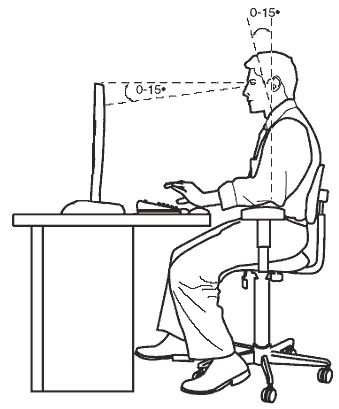
Types of video connectors
Know the video connectors on your computer and display devices to avoid problems and get the best possible picture quality.
There are two types of video transfer methods: Digital and Analog. If you try to connect a digital connector to an analog port or vise versa, you will not be able to view video. Also, if you attempt to play protected high-definition digital content, such as Blu-ray movies, over an analog connection, you will probably get an error message or the movie will play at lower quality resolutions.
HDMI (digital)
The HDMI connector is a digital connection type for transferring high-definition digital video signals AND audio signals. When used with a compatible monitor or television, HDMI has the capability of carrying true high-definition video and audio as well HDCP protected content (to play Blu-ray high-definition movies). If your computer has HDMI audio, it should be set as the default audio device in Windows audio properties (available from Windows Control Panel). The monitor or TV with HDMI must have speakers to hear audio.
Figure : HDMI connection

Display Port (digital)
The DisplayPort connector is a digital connection type for sending high-definition digital video signal AND an audio signal to a monitor with a DisplayPort connector. Display has very similar characteristics to HDMI but can also support a content protection method called DPCP in addition to the common format HDCP.
Figure : DisplayPort connection
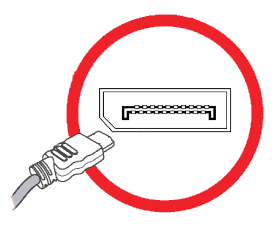
DVI (digital/analog)
The DVI connector is a connector for sending a digital video signal to a display device. Use VGA or DVI, but not both at the same time. Some display devices have both a VGA connector and a DVI connector. If your PC supports DVI, try using the VGA for a while and then try using the DVI connection for a while. Then, use the connection that provides the best picture quality for your display device.
DVI-I 
Carries both digital and analog signals. If your computer has a DVI-I port, you can connect to any DVI port on a monitor or TV or you can use a wide variety of adapters to connect to other types of ports.
DVI-D 
Carries only digital signals. If your computer has a DVI-D port, you can connect to DVI-I or DVD-D ports. You can often connect to other types of digital connections using adapters. Does not connect to a VGA port.
DVI-A 
Not common. Carries only analog signals. If your computer has a DVI-A port, you can connect to DVI-I or DVD-A ports. You can connect to a VGA port using an adapter. Does not connect to digital ports.
Figure : DVI connector
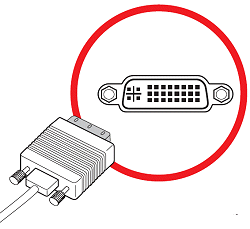
VGA and SVGA (analog)
The VGA connector is a video connection for sending analog video signals to the monitor or TV. Unless you are planning to connect to a special monitor, such as a plasma or LCD TV that has a DVI connector, connect your Primary monitor using the VGA connector.
Figure : VGA connection
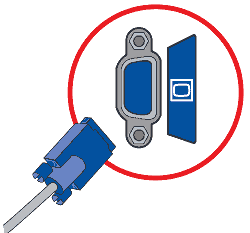
S-video and Composite (analog)
-
The S-video and Composite connectors are used to send an analog video signal to a secondary display device, such as a TV. In some cases it is possible to use these connections for the main display, such as for using a TV as the only monitor for a PC, but doing so is not recommended.
One example of using a secondary display is in a classroom environment; when connecting a video projector to a desktop computer that is already using a monitor, the instructor can use the primary monitor for performing the actions on the computer while students observe the projected image of what the instructor is doing.
Figure : S-video connector
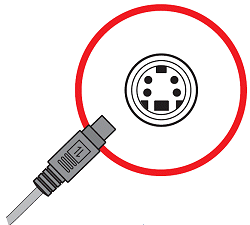
-
Figure : Composite connector
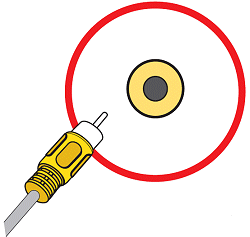
-
Connect the speaker and microphone cable, if those connections are available on the display device. Some display devices may have built-in speakers or a microphone. Connect these cables to the computer.
-
Connect the power cord to the display device and a power source.
caution:
HP recommends connecting the monitor or TV to a surge protection device as the power source to prevent damage to the monitor or TV if a power spike occurs.
Do not remove the video port cover
If your computer came with a graphics card, HP may have installed a plastic cover over the video port attached to the motherboard. This is because video has been set up to go through the graphics card for better performance. Most PCs can use graphics from the video card or the motherboard, but not both at the same time. If you remove the plastic cover to connect a monitor (usually VGA), the video will not work unless the video card is removed. The better solution is to connect an adapter to make the connection (see next section).
Figure : VGA connector cover Video card with 1 VGA port and 1 DVI port Covered VGA port - should not be used
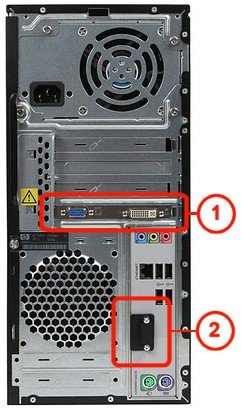
Using adaptors to help make the connection
Ideally, you want to have the same video connector on the PC and monitor or TV, but there may be times when this is not possible. When the video connector on the back of your computer does not match the video connector on the display device, you may need a special cable or adapter. For example, HP provides a small DVI to VGA adapter in the box with many of its computers. Connect this adapter to the DVI port on the computer and then connect the VGA cable from the monitor or TV into the adapter.
Figure : VGA to DVI adapter
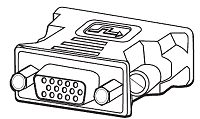
Another good answer may be a special cable that has different connection types on each end. Make sure you know the two types of video connectors before purchasing an adapter or cable.
Figure : Examples of adapters and cables
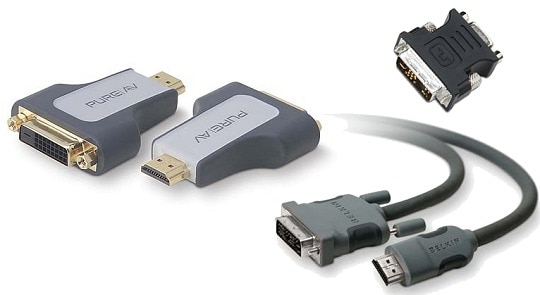
note:An HDMI connection can also carry audio. HDMI audio is lost when using a DVI to HDMI adapter or cable solution.
note:You cannot connect DVI-D to VGA.
Configuring the monitor
Use the following steps to provide Windows with the settings for your monitor, projector or TV:
-
Plug the monitor or TV into the computer.
-
Turn on the monitor or TV.
-
Turn on the computer.
-
When Windows opens, it should find the monitor(s) using Windows Plug and Play process. Give Windows extra time to start up while it installs the necessary files for the monitor or TV.
note:
Most monitors work fine without installing any software by using Microsoft's Plug and Play. However, if your monitor came with a software installation disc, you should install any drivers related to the monitor to get the best experience.
-
Once Windows has finished Plug and Play, right-click anywhere on the Windows desktop and select Screen Resolution to open a Display Properties window.
-
Set the Resolution slider to match the default resolution of your monitor.
For LED and LCD displays, refer to the box, user guide, or product specifications to find the native display resolution.
For older CRT monitors (the viewing area is a large glass tube) the display resolution can be set to whatever looks best - a good resolution for CRTs is 1024 x 768 or higher.
-
Click OK.
Your monitor has been installed.
note:If the picture displayed on the TV or monitor does not fit on the screen, or has blank areas to the sides of the screen, then use the TV or monitor zoom or aspect ratio feature. On TVs, aspect or zoom is usually found as a button on the remote control.
Setting properties for multiple monitors
Use one of the following sets of steps (depending on your operating system) to set up multiple monitors:
Windows 10
-
Search for and open Display Settings.
-
Click the drop-down menu for Multiple displays, select one of the configurations, then click Apply.
Figure : Multiple displays options
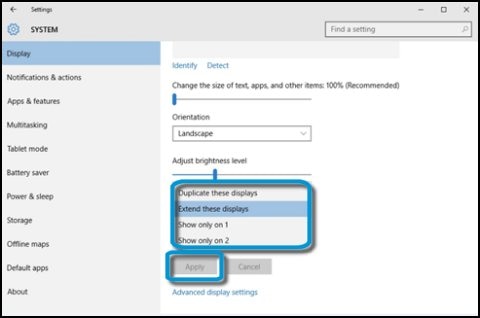
Duplicate these displays
Duplicate these displays, sometimes known as mirroring the displays, shows one desktop on all displays. This configuration is most commonly used for presentations; meaning that the presenter works from a smaller monitor while the audience views the presenter's work from a larger TV, monitor, or projector.
Figure : Duplicate displays

The computer is now ready to display the same screen on all output devices, from monitors to projectors. Press the fn and f4 function keys at the same time to switch the image from the PC display, to the external monitor, or to both.
Extend these displays
Extend these displays mode shows the Windows desktop extended across all displays. This configuration is most commonly used to get more workspace. You can take advantage of the extra workspace to view different applications on different displays.
note:When extending the workspace in Window 10 to two or more monitors, the Start screen appears on one of the monitors with the other monitors displaying desktop space.
Figure : Extended displays

To help identify your monitors, click Identify Monitors. The numbers 1 or 2 are shown on the monitor icons to help you identify them.
(Optional) To adjust the resolution, in the Display Settings window, select a monitor and slide the resolution slide bar. Click OK to save the setting and exit.
Show desktop on only one display
Show the desktop on only one display is similar to the extended desktop, except that the desktop is shown on only one display. The extra display will be blank, but still functions as an extension of your desktop. You can use this function to hide the desktop during a presentation, but still see the desktop on your personal monitor.
Figure : Show only on 1

Switch between displays using function keys in Windows
The computer is now ready to display the same screen on all output devices, from monitors to projectors. Press the fn and f4 function keys at the same time to switch the image from the PC display, to the external monitor, or to both.
Windows 8
-
Right-click anywhere on the Windows desktop and select Screen Resolution to open a Display Properties windows.
-
Click the drop-down menu for Multiple displays, select one of the configurations, then click Apply.
Figure : Multiple displays options
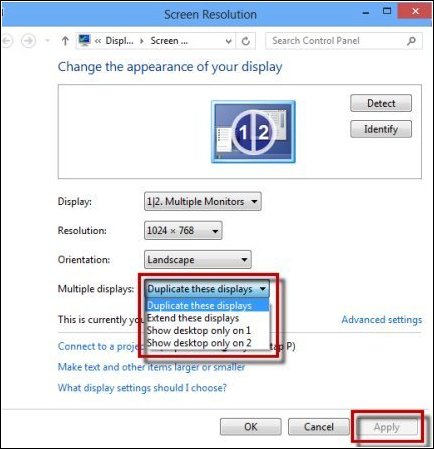
Duplicate these displays
Duplicate these displays, sometimes known as mirroring the displays, shows one desktop on all displays. This configuration is most commonly used for presentations; meaning that the presenter works from a smaller monitor while the audience views the presenter's work from a larger TV, monitor, or projector.
Figure : Duplicate displays

The computer is now ready to display the same screen on all output devices, from monitors to projectors. Press the fn and f4 function keys at the same time to switch the image from the PC display, to the external monitor, or to both.
Extend these displays
Extend these displays mode shows the Windows desktop extended across all displays. This configuration is most commonly used to get more workspace. You can take advantage of the extra workspace to view different applications on different displays.
note:When extending the workspace in Window 8 to two or more monitors, the Start screen appears on one of the monitors with the other monitors displaying desktop space.
Figure : Extended displays

To help identify your monitors, click Identify Monitors. The numbers 1 or 2 are shown on the monitor icons to help you identify them.
(Optional) To adjust the resolution, in the Display Settings window, select a monitor and slide the resolution slide bar. Click OK to save the setting and exit.
(Optional) To change the direction the desktop will extend (left or right to match how the displays are physically set up), select a monitor and drag it to the desired position.
Show desktop on only one display
Show the desktop on only one display is similar to the extended desktop, except that the desktop is shown on only one display. The extra display will be blank, but still functions as an extension of your desktop. You can use this function to hide the desktop during a presentation, but still see the desktop on your personal monitor.
Figure : Show only on 1

Switch between displays using function keys in Windows
The computer is now ready to display the same screen on all output devices, from monitors to projectors. Press the fn and f4 function keys at the same time to switch the image from the PC display, to the external monitor, or to both.
Windows 7
After connecting your TV or external monitor, you can choose a Windows desktop display configuration that works best for you.
-
Click Start, enter external in the search field, and select Connect to an external display when it becomes available in the list.
-
Find the drop-down menu for Multiple displays,
Figure : Multiple displays selection drop-down list
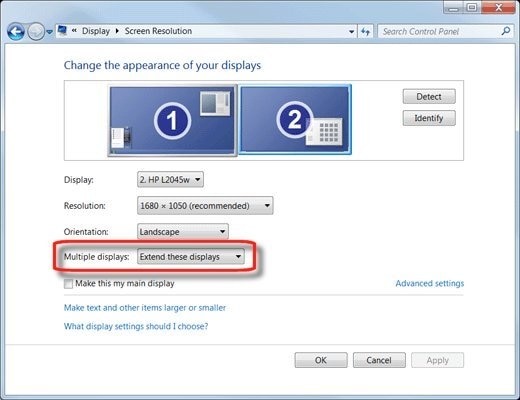
-
Select one of the configurations that works best for you:
-
Duplicate these displays: also know as mirroring the display output. Windows displays one screen to all connected displays. This configuration is most commonly used to show work being done on a presenter's monitor to an audience viewing a much larger image from a TV or projector.

-
Extend these displays: Increases the Windows desktop and provides the extra desktop space to additional connected monitors. This configuration is most commonly used to get more Windows desktop workspace.

To help identify your monitors, click Identify Monitors. The numbers 1 or 2 are shown on the corresponding screens.
Click and drag the images of the monitors in the window so that they represent the physical layout of your monitors.
(Optional) To adjust the resolution, in the Display Settings window, select a monitor and slide the resolution slide bar.
-
Show the desktop on only one display: is similar to the extended the desktop, except that the desktop is shown on only one display. Extra monitors are blank but still function as an extended Windows desktop space. You can use this function if you want to hide the screen during a presentation, but still use the primary screen.

-
-
Click Apply. The display configuration changes.
-
Click OK.
How to Use 2 Monitors on One Pc
Source: https://support.hp.com/us-en/document/c03319404
0 Response to "How to Use 2 Monitors on One Pc"
Post a Comment